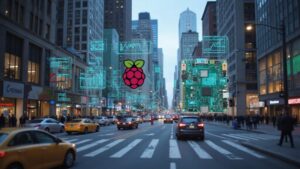Can you use a Raspberry Pi for Smart City Projects?
If you’re looking to enhance urban infrastructure with real-time insights and automated control, Raspberry Pi for smart city projects might be your ideal foundation. You can integrate it with IoT sensors to monitor energy use, track waste bins, or analyze water distribution. Its flexibility and affordable footprint make it well-suited for scaling citywide solutions. As you examine how to handle complex networking, data analytics, and remote management, you’ll want to weigh the specific challenges inherent in deploying these systems at city scale.
Key Takeaways
- Raspberry Pi offers a cost-effective platform for real-time data collection, processing, and automation in various smart city applications.
- It enables smart waste management by monitoring bin levels and automating collection schedules with connected sensors.
- The device supports energy management solutions, including real-time power grid monitoring and automated demand response for efficiency.
- Raspberry Pi facilitates environmental and water quality monitoring, allowing remote control and data-driven decisions for city utilities.
- Integration with IoT platforms and wireless networks makes Raspberry Pi scalable and adaptable for diverse urban infrastructure projects.
Smart City Infrastructure and the Role of Raspberry Pi for Smart City Projects
When it comes to building smart city infrastructure, integrating technology, sensors, and data analytics is essential for optimizing urban systems and services.
You can leverage Raspberry Pi as a core edge device in this ecosystem, enabling distributed real-time data collection and urban analytics. By deploying Raspberry Pi units across your city, you gain affordable, versatile gateways for monitoring traffic, environmental conditions, and public utilities. Their seamless integration with wireless communications and other IoT platforms supports robust infrastructure optimization—think of streamlining transportation networks or enhancing public safety through responsive sensors.
In addition, deploying Raspberry Pi can also facilitate smart waste management systems, using sensors and data analytics to optimize waste collection and minimize landfill contributions.
With programmable automation, you control and manage assets like streetlights and water meters efficiently. Energy-efficient buildings and smart grids can also be supported by Raspberry Pi, as these devices help minimize waste and carbon footprints through the automation and monitoring of resource consumption.
Raspberry Pi empowers you to prototype and scale solutions, ensuring urban analytics drive measurable, sustainable improvements in city operations.
Implementing IoT-Based Energy Management Systems

By integrating IoT-based energy management systems with Raspberry Pi, you can transform urban energy infrastructure for greater efficiency and sustainability.
Real-time monitoring lets you visualize and control energy consumption across city assets, while predictive analytics elevate grid reliability by forecasting demand patterns. By leveraging smart meters that provide real-time data on electricity usage, cities can more accurately track and adjust how and when energy is consumed.
Automated demand response and smart meters give you unprecedented precision in balancing load, optimizing both cost and resource use.
By leveraging these technologies, you address pressing environmental challenges and lead the charge towards smarter, greener cities.
Harnessing these innovations paves the way for resilient cities that set the standard in energy efficiency and environmental stewardship.
- See the difference: Real-time energy consumption data empowers instant action, reducing waste and inefficiency.
- Drive sustainability: Predictive analytics guide smart resource allocation, cutting emissions.
- Embrace innovation: Seamless integration of renewables guarantees clean energy for urban growth.
- Feel secure: Automated control enhances system stability, ensuring reliable service.
Thanks to the integration of cloud computing and real-time data, city managers can instantly process, analyze, and respond to fluctuations in energy usage, maximizing efficiency at scale.
Raspberry Pi Applications in Waste Collection and Monitoring
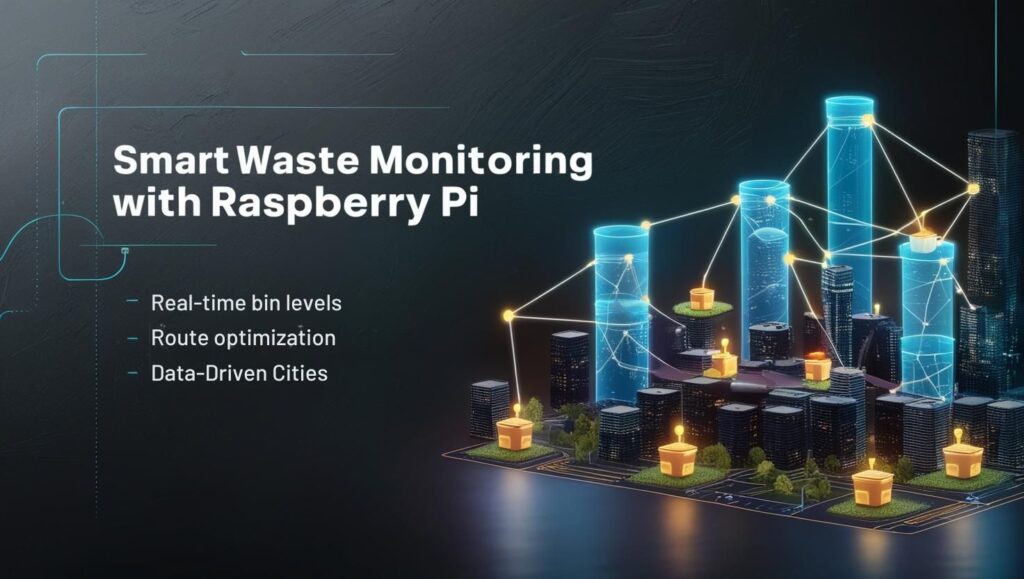
Smart city initiatives don’t stop at just optimizing energy systems; you can deploy Raspberry Pi to tackle urban waste management challenges head-on.
By integrating ultrasonic and infrared sensors, your system tracks garbage levels, automates lid mechanisms with servo motors, and boosts bin efficiency. Waste tracking improves through real-time alerts—garbage collectors know exactly when bins reach capacity, reducing unnecessary pickups. Raspberry Pi Camera Module functions as the image classifier’s eyes, letting your setup visually identify waste in real time and tailor responses accordingly.
Leveraging IoT, you connect multiple bins via WiFi and MQTT protocols, supporting scalable solutions. Distributed dustbins equipped with sensors efficiently transmit their data to central servers for processing, enabling reliable monitoring and analytics to support prompt collection decisions. Installing camera modules and machine learning models allows customization for local waste sorting, with LEDs offering user feedback on detected trash types.
Central management via AWS and real-time dashboards enables actionable insights. Although precise location data remains a limitation, your setup’s modularity guarantees straightforward integration and monitoring advancements.
Enhancing Water Distribution With Real-Time Analytics
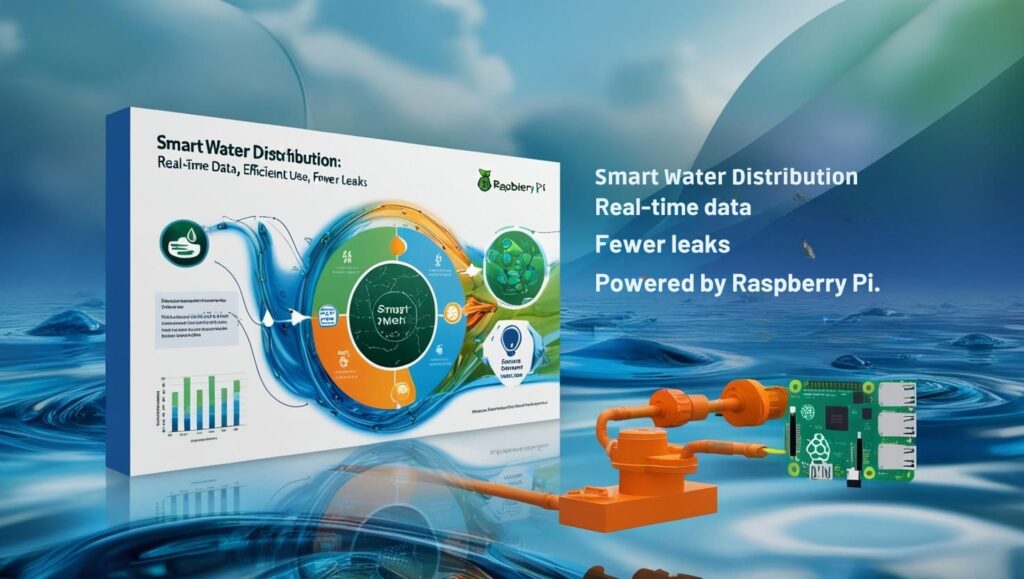
Although urban water systems face rising demands and aging infrastructure, Raspberry Pi provides a robust platform for optimizing water distribution through real-time analytics.
By leveraging Raspberry Pi, you can automate critical water treatment processes—monitoring flow, turbidity, and equipment statuses using sensors and GPIO interfaces. This allows precise pump and valve control tailored to real-time water quality data.
Harnessing Raspberry Pi enables automated, sensor-driven water treatment, ensuring responsive pump and valve control based on live system data.
Integration with cloud platforms empowers remote oversight, while Python-based GUIs deliver at-a-glance system diagnostics. Open-source design allows customization and expansion to fit unique requirements of any city’s water network. Its incorporation of Raspberry Pi for system functionality demonstrates how affordable computing can support complex urban infrastructure needs.
In municipal networks and automated irrigation, data-driven decisions reduce waste and guarantee compliance with quality standards.
Here’s how Raspberry Pi transforms water management:
- Real-time water quality monitoring triggers instant alerts and swift corrective actions.
- Automated irrigation responds directly to soil moisture, optimizing every drop.
- Data analytics detect leaks, preventing costly losses.
- Remote system control enhances transparency and accountability.
Power Grid Surveillance and Safety Improvements
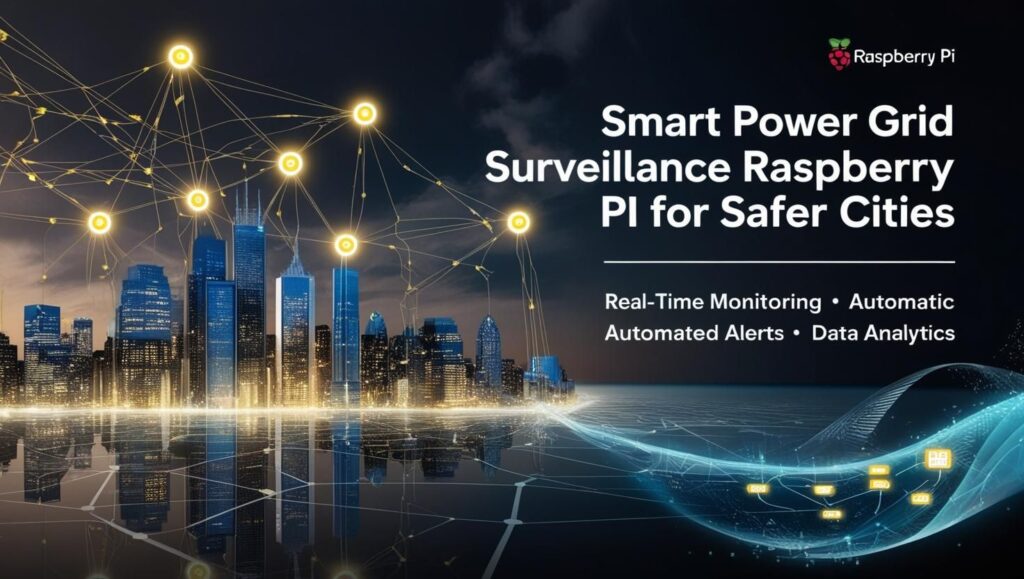
You can deploy Raspberry Pi units for real-time power line monitoring by connecting them to current and voltage sensors, enabling prompt detection of anomalies and outages. The low idle power consumption of newer Raspberry Pi models makes them suitable for continuous deployment in distributed locations without excessive energy demands. Open source platforms like those used for AI-driven traffic monitoring provide flexibility and customizability for adapting surveillance solutions to varied grid environments. Integrate the Pi with intrusion detection technologies, such as PIR motion sensors and surveillance cameras, to secure grid infrastructure against unauthorized access.
Real-Time Power Line Monitoring
By leveraging Raspberry Pi with a robust mix of current transformers, voltage sensors, and advanced monitoring software, you can implement real-time power line surveillance systems that boost both grid safety and operational efficiency.
Integrate platforms like Open Energy Monitor for processing real time data, and display actionable results through Grafana dashboards for smart city stakeholders. For optimal reliability, it’s recommended to monitor power supply stability using scripts or sensors—preventing undervoltage or sudden current drops that can affect data integrity during surveillance.
Clamp-on current transformers and voltage sensors allow seamless, non-intrusive monitoring, while opto-isolators keep your system safe from hazardous voltages.
With custom hardware & software working hand in hand, these solutions monitor power consumption and generation in real time, storing critical data for intuitive dashboard visualization.
Ensuring reliable network connectivity and power backup will keep your monitoring system resilient even during outages, optimizing grid efficiency.
Here’s why you should act now:
- Prevent outages before they escalate.
- Uncover hidden inefficiencies draining resources.
- Respond instantly to hazardous anomalies.
- Deliver actionable insights, driving innovation.
Intrusion Detection Technologies
Securing critical power grid infrastructure demands intrusion detection technologies that can adapt quickly to evolving threats while remaining cost-effective and reliable.
With Raspberry Pi, you can deploy a flexible, energy-efficient platform that supports continuous network security monitoring at remote substations. Configure tools like Snort for real-time packet inspection or Pi.Alert to detect unauthorized network activity, seamlessly integrating both virtual and physical sensors through GPIO pins. Raspberry Pi-based intrusion detection tools such as Pi.Alert can be quickly installed and configured with minimal hardware requirements and user-friendly installation scripts.
Raspberry Pi offers flexibility in deployment and configuration, making it especially useful for tailored monitoring in diverse substation environments.
This combination bridges the gap between digital threats and perimeter security—crucial for robust power grid surveillance. While Pi-based intrusion detection systems can efficiently identify attacks—brute force, spoofing, or scanning—be mindful of their processing limitations under heavy traffic.
Tailoring precise rules for power grid protocols and integrating secure alert channels guarantees effective, decentralized safety improvements for smart city grid environments.
Traffic Accident Detection Using Sensor Networks
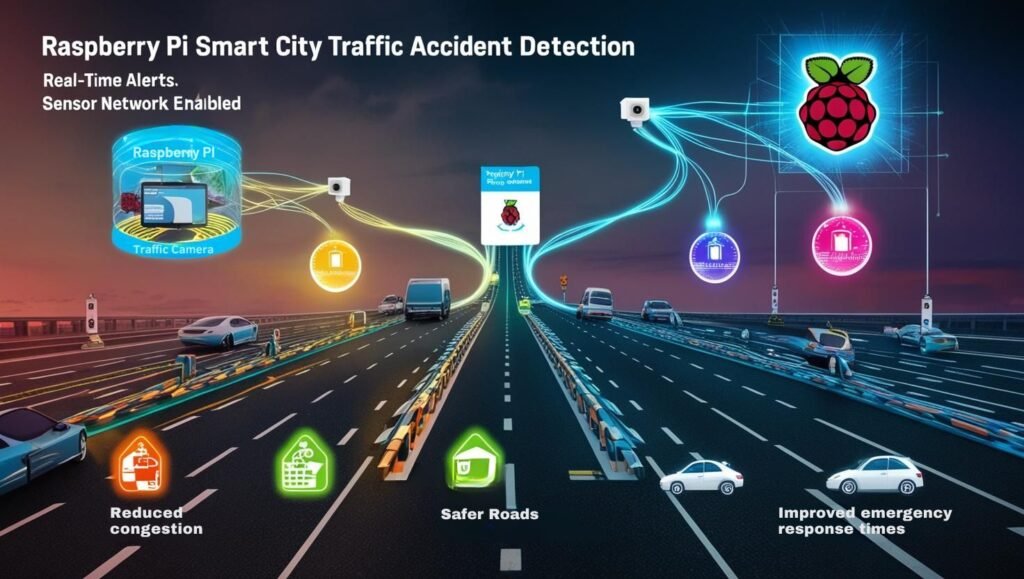
Although urban environments present complex traffic scenarios, sensor networks play an essential role in detecting and reporting traffic accidents with speed and accuracy. By integrating various sensors—like accelerometers, gyroscopes, and GPS—into smart road infrastructure, you can automate accident detection and enhance real-time accident response.
A Raspberry Pi serves as a robust processing hub, seamlessly managing data from distributed wireless sensor nodes and communicating over protocols such as Zigbee or WLAN. These systems enable rapid localization and centralized database storage for accident details, facilitating swift emergency interventions. Effective sensor integration guarantees less downtime and immediate alerts. The MCU’s real-time analysis of sensor data allows for precise differentiation between normal driving conditions and actual accidents, ensuring that emergency services respond only to genuine incidents.
Consider how this technology impacts lives:
- Faster emergency response minimizes injuries and fatalities.
- Real-time data empowers authorities to act decisively.
- Cost-effective solutions make cities more accessible.
- Reliable detection fosters safer road environments.
Public Health Deployments in Urban Environments
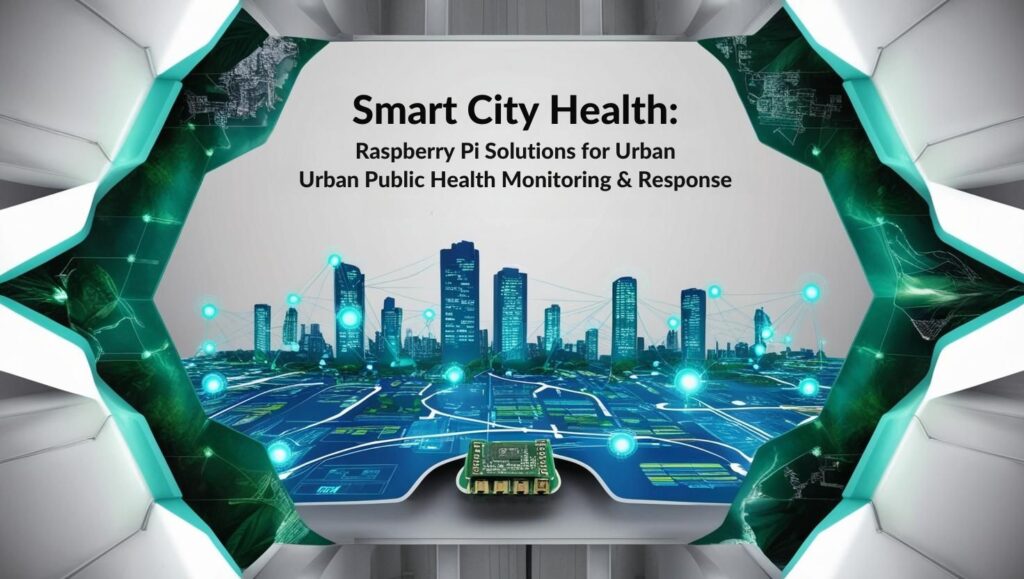
You can leverage Raspberry Pi systems for real-time disease surveillance and remote patient monitoring across urban environments. Integrate environmental sensors, biometric devices, and cloud platforms to quickly detect outbreaks and track patient health metrics citywide. Raspberry Pi serves as data logger in natural asset management, making it an adaptable solution for a variety of smart city applications. Distributed networks of low-cost air quality sensors built on Raspberry Pi can enhance public health deployments by providing hyperlocal data critical for rapid decision-making.
Real-time Disease Surveillance
While rapid urbanization intensifies public health challenges, integrating Raspberry Pi devices into real-time disease surveillance systems offers cities a scalable, cost-effective approach to early outbreak detection and response.
By connecting Raspberry Pi nodes with IoT sensors, you can automate disease tracking and enhance outbreak prediction in densely populated areas.
Big data analytics and wireless sensor networks work together to process streams of health data instantly, supporting swift interventions. Managing these interconnected sensors and devices relies on robust database foundations to ensure timely, coordinated data analysis at city-wide scale.
Video surveillance systems (VSS) in smart cities illustrate how real-time monitoring and analytics can also be leveraged for public health purposes, providing proactive responses to emerging threats.
Seamless integration with telehealth platforms further improves the ability to identify threats in real time, ensuring more resilient urban health infrastructures.
- Harness IoT data streams for early disease tracking and actionable outbreak prediction.
- Deploy cost-effective Raspberry Pi-driven surveillance across urban environments.
- Empower public health response with automated, predictive data analytics.
- Transform symptom reporting with integrated mobile apps and real-time alerts.
Remote Patient Monitoring
As urban populations grow and healthcare demands intensify, deploying Raspberry Pi-driven remote patient monitoring systems offers a scalable solution for continuous, real-time health oversight across diverse environments.
You can integrate lightweight, wearable sensors with a Raspberry Pi gateway—measuring ECG, blood pressure, heart rate, and SpO₂—while prioritizing patient comfort and mobility.
Signals are processed and transmitted securely to the cloud using robust protocols like WiFi or GSM, ensuring data security and immediate caregiver alerts if any critical sign crosses a critical threshold. Integration of multiple sensors enhances reliability and portability, making it possible to monitor various health parameters with a single device.
With HMI touchscreens, patients and staff access real-time updates locally, while physicians review encrypted records remotely via web portals or mobile apps.
Multi-patient monitoring, secure authentication, and IoT platform integration optimize clinical workflows for urban health, all while maintaining confidentiality and scalability.
Networking and Communication Protocols for Smart Cities

A robust networking and communication infrastructure forms the backbone of smart city deployments, ensuring seamless interaction among diverse devices and subsystems.
When you deploy Raspberry Pi nodes in urban environments, network scalability and protocol standardization become essential for future-proofing your system. Leverage standardized protocols like TALQ to seamlessly integrate multi-vendor IoT devices controlled by a centralized management system.
Edge and cloud computing enable real-time data processing, enhancing efficiency.
You’ll face several technical challenges when integrating city-wide networks:
- Overcoming proprietary protocol barriers to streamline interoperability and reduce vendor lock-in.
- Ensuring network scalability as sensor deployments multiply and demand flexibility.
- Implementing redundancy and fault tolerance for continuous, resilient operations.
- Integrating new technologies—like 5G and AI-driven management—to accelerate innovation and enable dynamic smart city growth.
Frequently Asked Questions
What Is the Typical Cost of Deploying Raspberry Pi Devices in a Smart City Project?
When you conduct cost analysis for deployment, consider hardware ($5–$55 per unit), sensor integration, connectivity, and development. Smart budgeting guarantees system integration remains affordable, while scalability and innovation drive budget considerations for expanding your project efficiently.
How Long Do Raspberry Pi Devices Typically Last When Used Outdoors?
When you deploy Raspberry Pi devices outdoors, expect 1–3 years of outdoor durability with active device maintenance. You’ll extend lifespan by optimizing enclosures, managing moisture, monitoring temperatures, and prioritizing system integration with high-quality power supplies and SD cards.
Are Raspberry Pis Secure Against Cyberattacks in Urban IoT Deployments?
Don’t assume Raspberry Pis are invulnerable—you risk exposure without strict security measures. You must deploy regular updates, strong authentication, and network segmentation to boost cyberattack prevention, ensuring system integration that anticipates threats and supports your drive for innovative deployments.
Can Raspberry Pi Units Operate Reliably in Extreme Weather Conditions?
You can trust Raspberry Pi durability in many harsh scenarios, as its extreme weather performance spans -42°C to 90°C. To boost reliability, integrate heaters, use insulated enclosures, and select industrial-grade components for longer uptime and system integration.
What Programming Languages Are Best for Raspberry Pi-Based Smart City Applications?
Even if you worry about scalability, you’ll find Python frameworks and JavaScript libraries offer robust, scalable solutions. They streamline sensor integration, automation, and user interfaces, while C/C++ guarantees low-level efficiency for real-time, high-performance system integration.
Conclusion
By harnessing Raspberry Pi as the “central nervous system” of your smart city initiatives, you’ll streamline integration, real-time monitoring, and automation across each urban domain. Its flexibility lets you weave together IoT solutions with reliable communication protocols—solving challenges in energy, waste, water, safety, and public health. With technical precision, you can build a connected, resilient urban fabric that not only responds to current needs but adapts as your city grows smarter and more sustainable.

I am a retired software engineer with experience in a multitude of areas including managing AWS and VMWare development environments. I bought a relative a mini-PC a year ago and have become passionate about the technology and its potential to change how we deploy software.

